Emissions from Building Materials—A Threat to the Environment?
Abstract
:1. Introduction
2. Materials and Methods
2.1. Field Study
2.1.1. Test Sites
2.1.2. Monitoring Strategy
2.2. Simulation of Runoff and Emissions
3. Results and Discussion
3.1. Field Study
3.2. Modelling
4. Conclusions
Supplementary Materials
Author Contributions
Funding
Informed Consent Statement
Data Availability Statement
Acknowledgments
Conflicts of Interest
Appendix A
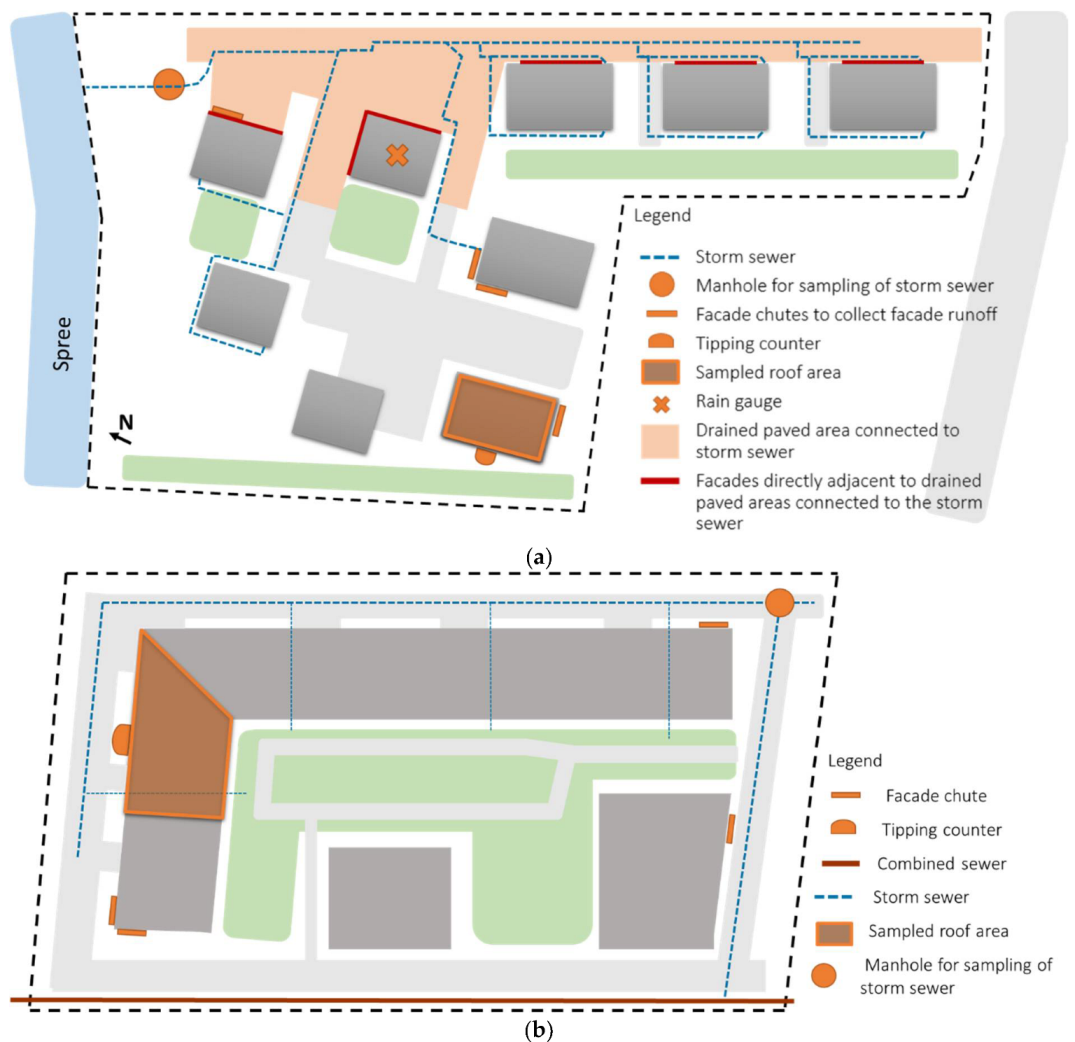

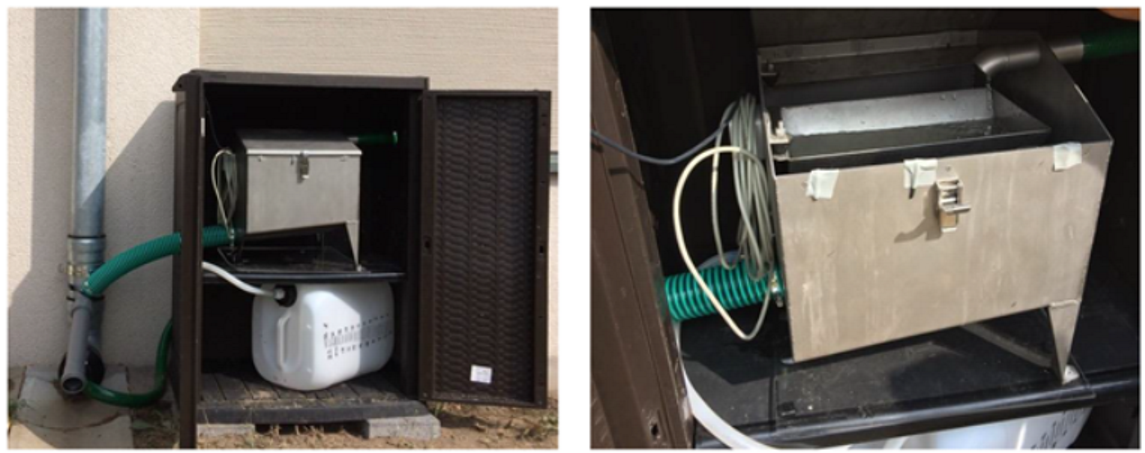
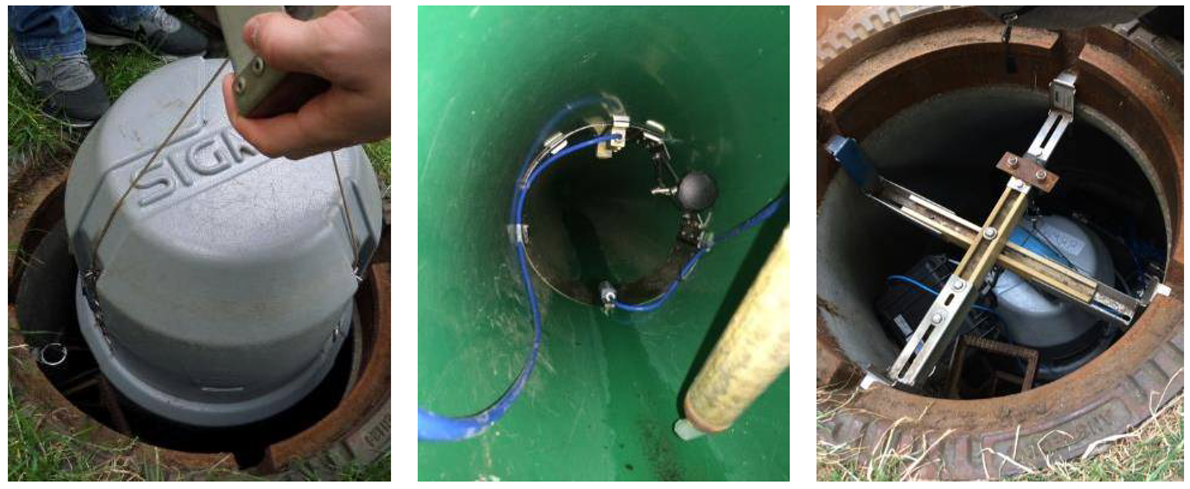
| Compound | Limit of Quantification [µg/L] |
|---|---|
| Diuron | 0.025 |
| Diuron-desmethyl (DCPMU; TP) | 0.025 |
| Isoproturon | 0.025 |
| Iodocarb (IPBC) | 0.05 |
| MCPA | 0.025 |
| Mecoprop | 0.025 |
| Octhilinone (OIT) | 0.1 |
| Terbutryn | 0.025 |
| Terbumeton (TP) | 0.025 |
| Terbutryn-desethyl (TP) | 0.025 |
| Terbutryn-2-hydroxy (TP) | 0.025 |
| Aluminium (Al) | 5.0 |
| Copper (Cu) | 5.0 |
| Vanadium (V) | 2.0 |
| Zinc (Zn) | 5.0 |
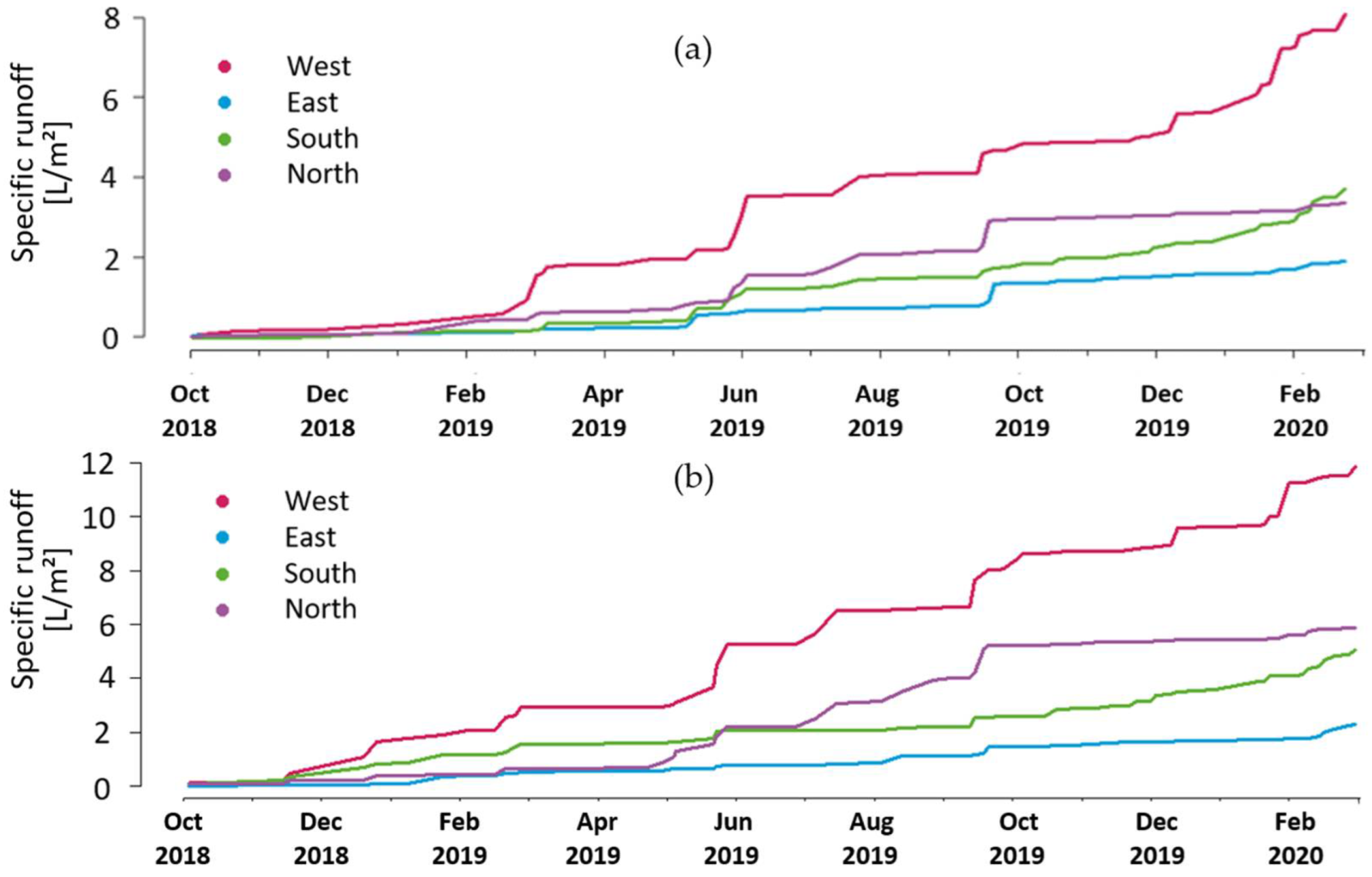


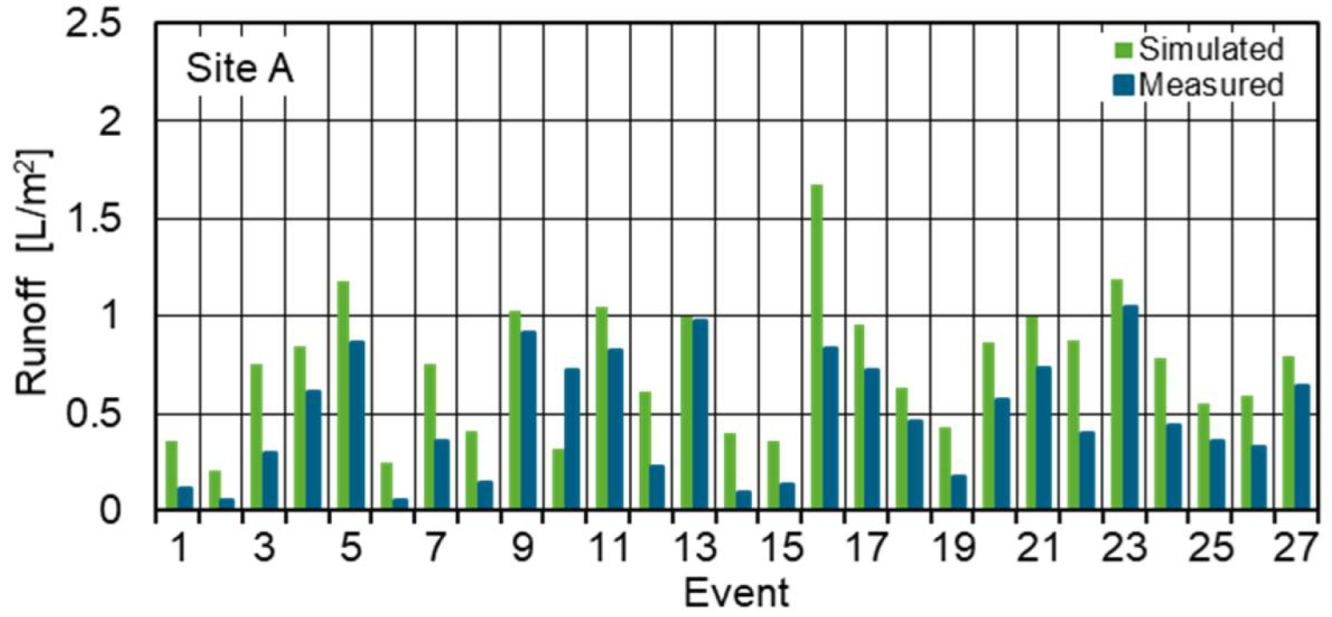
References
- Göbel, P.; Dierkes, C.; Coldewey, W.G. Storm water runoff concentration matrix for urban areas. J. Contam. Hydrol. 2007, 91, 26–42. [Google Scholar] [CrossRef] [PubMed]
- Müller, A.; Österlund, H.; Nordqvist, K.; Marsalek, J.; Viklander, M. Building surface materials as sources of micropollutants in building runoff: A pilot study. Sci. Total Environ. 2019, 680, 190–197. [Google Scholar] [CrossRef] [PubMed]
- Björklund, K.; Cousins, A.P.; Strömvall, A.-M.; Malmqvist, P.-A. Phthalates and nonylphenols in urban runoff: Occurrence, distribution and area emission factors. Sci. Total Environ. 2009, 407, 4665–4672. [Google Scholar] [CrossRef] [PubMed]
- Odnevall Wallinder, I.; Hedberg, Y.; Dromberg, P. Storm water runoff measurements of copper from a naturally patinated roof and from a parking space. Aspects on environmental fate and chemical speciation. Water Res. 2009, 43, 5031–5038. [Google Scholar] [PubMed]
- Bucheli, T.; Müller, S.; Voegelin, A.; Schwarzenbach, R. Bituminous Roof Sealing Membranes as Major Sources of the Herbicide (R,S)-Mecoprop in Roof Runoff Waters: Potential Contamination of Groundwater and Surface Waters. Environ. Sci. Technol. 1998, 32, 3465–3471. [Google Scholar] [CrossRef]
- Blocken, B.; Derome, D.; Carmeliet, J. Rainwater runoff from building facades: A review. Build. Environ. 2013, 60, 339–361. [Google Scholar] [CrossRef]
- Schoknecht, U.; Gruycheva, J.; Mathies, H.; Bergmann, H.; Burkhardt, M. Leaching of biocides used in façade coatings under laboratory test conditions. Environ. Sci. Technol. 2009, 43, 9321–9328. [Google Scholar] [CrossRef] [PubMed]
- Burkhardt, M.; Zuleeg, S.; Vonbank, R.; Bester, K.; Carmeliet, J.; Boller, M.; Wangler, T. Leaching of biocides from Façades under natural weather conditions. Environ. Sci. Technol. 2012, 46, 5497–5503. [Google Scholar] [CrossRef] [PubMed]
- Bollmann, U.E.; Minelgaite, G.; Schlüsener, M.; Ternes, T.; Vollertsen, J.; Bester, K. Leaching of Terbutryn and Its Photodegradation Products from Artificial Walls under Natural Weather Conditions. Environ. Sci. Technol. 2016, 50, 4289–4295. [Google Scholar] [CrossRef] [PubMed]
- Schoknecht, U.; Mathies, H.; Wegner, R. Biocide leaching during field experiments on treated articles. Environ. Sci. Eur. 2016, 28, 6. [Google Scholar] [CrossRef] [PubMed] [Green Version]
- Wicke, D.; Matzinger, A.; Sonnenberg, H.; Caradot, N.; Schubert, R.L.; Dick, R.; Heinzmann, B.; Dünnbier, U.; von Seggern, D.; Rouault, P. Micropollutants in urban stormwater runoff of different land uses. Water 2021, 13, 1312. [Google Scholar] [CrossRef]
- Gasperi, J.; Sebastian, C.; Ruban, V.; Delamain, M.; Percot, S.; Wiest, L.; Mirande, C.; Caupos, E.; Demare, D.; Kessoo, M.D.K.; et al. Micropollutants in urban stormwater: Occurrence, concentrations, and atmospheric contributions for a wide range of contaminants in three French catchments. Environ. Sci. Pollut. Res. 2014, 21, 5267–5281. [Google Scholar] [CrossRef] [PubMed] [Green Version]
- Bollmann, U.E.; Vollertsen, J.; Carmeliet, J.; Bester, K. Dynamics of biocide emissions from buildings in a suburban stormwater catchment—Concentrations, mass loads and emission processes. Water Res. 2014, 56, 66–76. [Google Scholar] [CrossRef]
- Masoner, J.R.; Kolpin, D.W.; Cozzarelli, I.M.; Barber, L.B.; Burden, D.S.; Foreman, W.T.; Forshay, K.J.; Furlong, E.T.; Groves, J.F.; Hladik, M.L.; et al. Urban Stormwater: An Overlooked Pathway of Extensive Mixed Contaminants to Surface and Groundwaters in the United States. Environ. Sci. Technol. 2019, 53, 10070–10081. [Google Scholar] [CrossRef] [Green Version]
- ECHA. Emission Scenario Documents. 2021. Available online: https://echa.europa.eu/de/guidance-documents/guidance-on-biocides-legislation/emission-scenario-documents (accessed on 16 January 2022).
- Wode, F.; van Baar, P.; Dünnbier, U.; Hecht, F.; Taute, T.; Jekel, M.; Reemtsma, T. Search for over 2000 current and legacy micropollutants on a wastewater infiltration site with a UPLC-high resolution MS target screening method. Water Res. 2015, 69, 274–283. [Google Scholar] [CrossRef]
- Tietje, O.; Burkhardt, M.; Rohr, M.; Borho, N.; Schoknecht, U. Emissions- und Übertragungsfunktionen für die Modellierung der Auslaugung von Bauprodukten; Umweltbundesamt: Dessau-Roßlau, Germany, 2018. [Google Scholar]
- Hensen, B.; Lange, J.; Jackisch, N.; Zieger, F.; Olsson, O.; Kümmerer, K. Entry of biocides and their transformation products into groundwater via urban stormwater infiltration systems. Water Res. 2018, 144, 413–423. [Google Scholar] [CrossRef] [PubMed]
- SenStadtUm (Berlin Senate Department for Urban Development and Environmental Protection). Handlungsempfehlungen zur Vermeidung der Umweltbelastung Durch die Freisetzung des Herbizids Mecoprop aus Wurzelfesten Bitumenbahnen [Recommendations for the Avoidance of Pollution by Emission of the Herbicide Mecoprop from Bituminous Roofing Membranes with Root Protection]; SenStadtUm (Berlin Senate Department for Urban Development and Environmental Protection): Berlin, Germany, 2013. (In German) [Google Scholar]
- Burkhardt, M.; Zuleeg, S.; Vonbank, R.; Schmid, P.; Hean, S.; Lamani, X.; Bester, K.; Boller, M. Leaching of additives from construction materials to urban storm water runoff. Water Sci. Technol. 2011, 63, 1974–1982. [Google Scholar] [CrossRef] [PubMed]
- Wenzel, A.; Schlich, K.; Shemotyuk, L.; Nendza, M. Revision der Umweltqualitätsnormen der Bundes-Oberflächengewässerverordnung nach Ende der Übergangsfrist für Richtlinie 2006/11/EG und Fortschreibung der Europäischen Umweltqualitätsziele für Prioritäre Stoffe; Texte 47/2015; Umweltbundesamt (UBA): Dessau-Roßlau, Germany, 2015. [Google Scholar]
- UBA. ETOX-Portal: Information System on Ecotoxicology and Environmental Quality Targets. 2021. Available online: https://webetox.uba.de/webETOX/public/basics/stoff/ziel.do;?stoff=128625 (accessed on 16 January 2022).
- Wicke, D.; Rouault, P.; Rohr, M.; Burkhardt, M. Guter Umgang mit Regenwasser—Ein Leitfaden für Nachhaltiges Bauen. Vermeidung von Stofflichen Belastungen im Regenabfluss von Gebäuden. Leitfaden mit 3 Maßnahmensteckbriefen (Fassade, Dach, Grundstück). Umweltbundesamt. 2021, p. 21. Available online: https://www.umweltbundesamt.de/sites/default/files/medien/2503/dokumente/210412_basar_leitfaden_mit_steckbriefen.pdf (accessed on 16 January 2022). (In German).
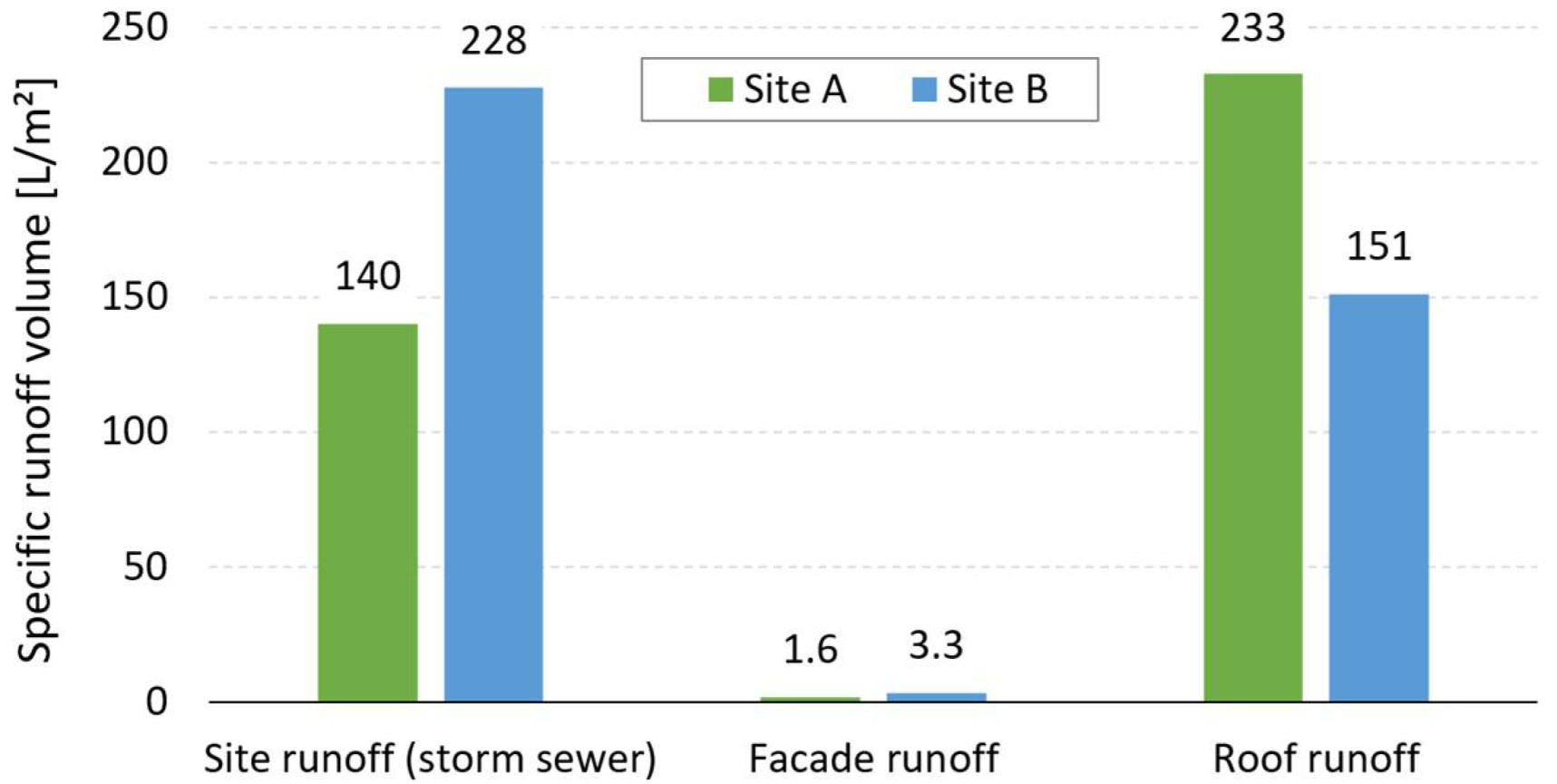
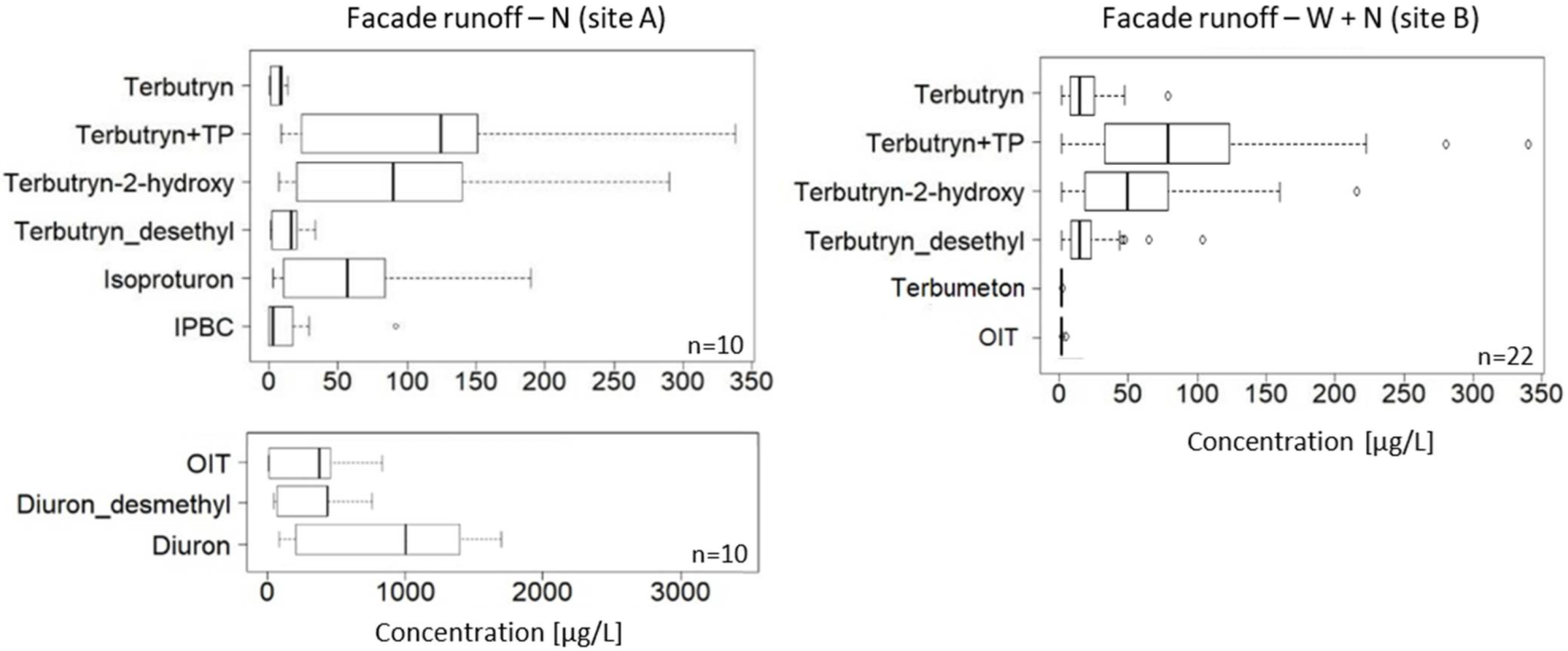



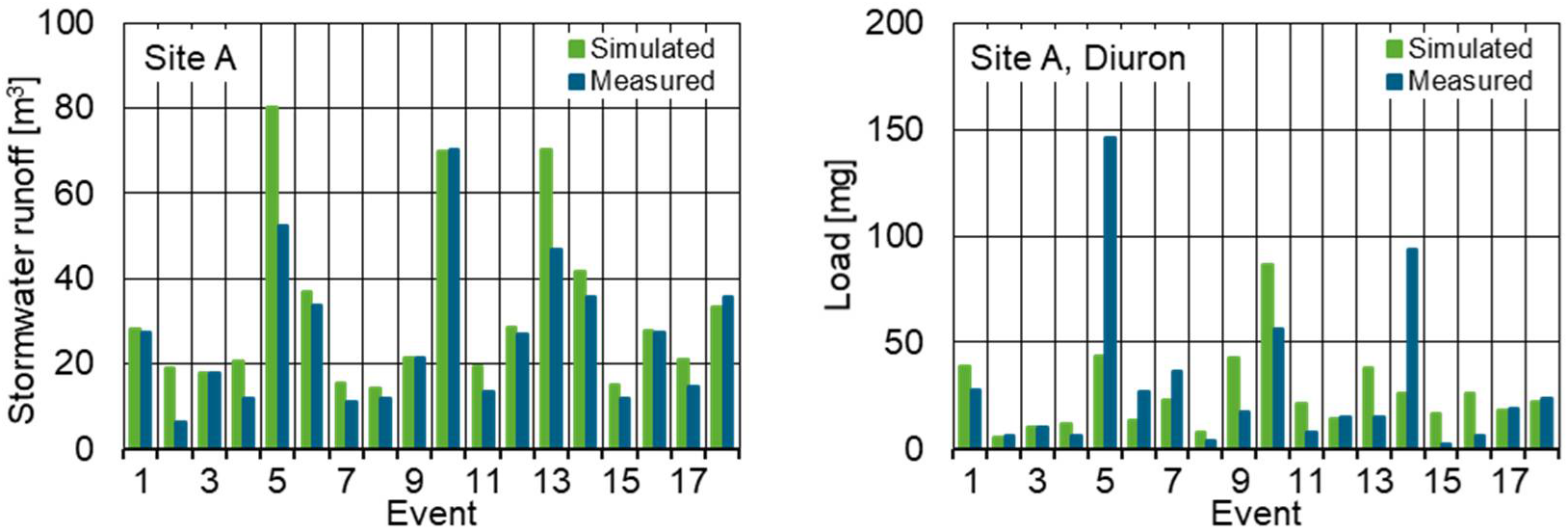

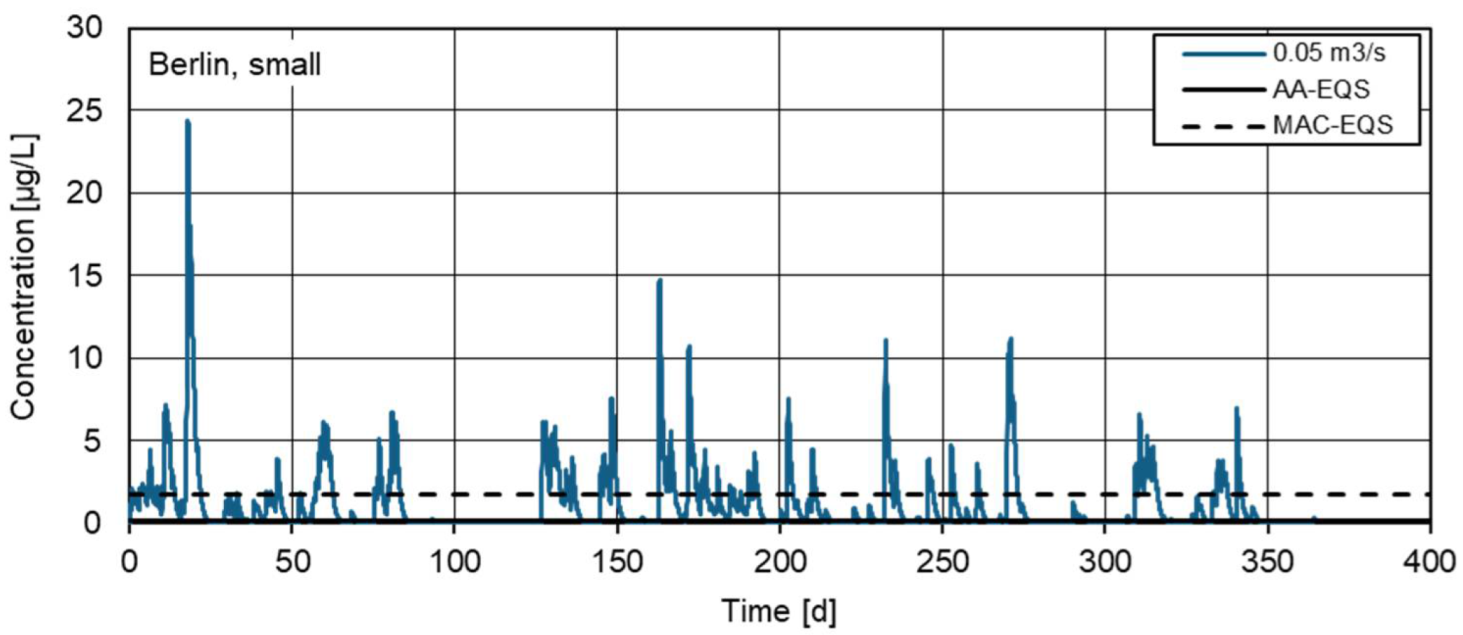
Publisher’s Note: MDPI stays neutral with regard to jurisdictional claims in published maps and institutional affiliations. |
© 2022 by the authors. Licensee MDPI, Basel, Switzerland. This article is an open access article distributed under the terms and conditions of the Creative Commons Attribution (CC BY) license (https://creativecommons.org/licenses/by/4.0/).
Share and Cite
Wicke, D.; Tatis-Muvdi, R.; Rouault, P.; Zerball-van Baar, P.; Dünnbier, U.; Rohr, M.; Burkhardt, M. Emissions from Building Materials—A Threat to the Environment? Water 2022, 14, 303. https://doi.org/10.3390/w14030303
Wicke D, Tatis-Muvdi R, Rouault P, Zerball-van Baar P, Dünnbier U, Rohr M, Burkhardt M. Emissions from Building Materials—A Threat to the Environment? Water. 2022; 14(3):303. https://doi.org/10.3390/w14030303
Chicago/Turabian StyleWicke, Daniel, Roberto Tatis-Muvdi, Pascale Rouault, Patricia Zerball-van Baar, Uwe Dünnbier, Mirko Rohr, and Michael Burkhardt. 2022. "Emissions from Building Materials—A Threat to the Environment?" Water 14, no. 3: 303. https://doi.org/10.3390/w14030303
APA StyleWicke, D., Tatis-Muvdi, R., Rouault, P., Zerball-van Baar, P., Dünnbier, U., Rohr, M., & Burkhardt, M. (2022). Emissions from Building Materials—A Threat to the Environment? Water, 14(3), 303. https://doi.org/10.3390/w14030303








